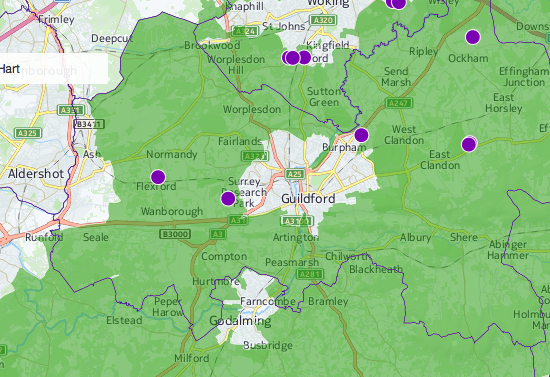 Abraham Lincoln
If given the truth, the people can be depended upon to meet any national crisis...
Abraham Lincoln
If given the truth, the people can be depended upon to meet any national crisis...
 Guildford news...
for Guildford people, brought to you by Guildford reporters - Guildford's own news service
Guildford news...
for Guildford people, brought to you by Guildford reporters - Guildford's own news service
Letter: Planning Decisions Affecting Green Belt Need Collaboration to Achieve Consensus
Published on: 25 Jul, 2022
Updated on: 25 Jul, 2022
Spokesperson for The Green Party in Guildford
In response to: The Green Belt Gives Us the Opportunity to Grow
I sympathise with Howard Smith and Brian Creese’s fight to ensure affordable homes for younger generations. The median salary in Guildford is £36k. The median one bedroom property is £255k.
If someone was lucky enough to save a 20 per cent deposit (which would take almost 10 years saving £500 per month), they would still require a mortgage six times the median salary, which they would never be granted. So it is absolutely correct to conclude that the younger generations are forced into a renters market as a result of property prices that have outstripped wage growth year-on-year, leaving prices unaffordable to the majority of local residents.
Where I disagree with Howard Smith is the impact house building would have on prices. It ignores the impact speculators are having on the market. Looking at how property prices have continued to soar despite the number of new houses outstripping the number of new households highlights this fact. Without government intervention in the market (bigger increase of stamp duty for second homes, more restrictions on buy-to-let, taxing empty homes, etc), simply building new houses will not bring prices down.
That isn’t to say Mr Smith is wrong that more houses are needed in Guildford. I heard stories of university students commuting from Aldershot, something I never heard of when I attended the University of Surrey back in 2006, and council housing waiting lists remain a problem.
Rents continue to soar leaving many people struggling to feed themselves and their families. Yet most people I encounter acknowledge that more housing is needed in Guildford. Where we differ is on the type of housing and, most importantly, the location.
Howard’s original article points to the use a small portion of green belt to increase the number of properties being built. This is an attractive option to many, not least a developer. Yet the replies show the extent of local opposition to any green belt development, and this opposition is not just a vocal few, as seen through the electoral success of both GGG and R4GV.
My own Party (The Green Party) vehemently oppose building on green belt land, and it is primarily for this reason that our councillor joined the R4GV group on the council as they sought to review the Local Plan.
Yet I wonder if there is a way through this issue in which broad support could be found. Not all green belt is of equal ecological value, and not all developments have the same ecological/environmental footprint or social value.
An isolated development of 4/5 bedroom detached housing built on green belt land that would include the clearing of trees and vegetation that are important for the local ecosystem should rightly be opposed. Yet how many people would oppose a development of medium-high density social housing on low ecological value green belt land with good existing public transport links or potential for new public transport links?
No doubt such a list of conditions for development on green belt land would make finding any suitable locations challenging. It would require an assessment of public transport throughout the borough, including highlighting potential new routes. It would need an extensive environmental survey covering all of the areas accessible by these routes.
It would also require local authority funding and, most challenging of all, it would require collaboration across every tier of government and the private sector. It is a tall ask, but it is what we should be striving for.
Recent Articles
- Guildford Institute’s Crowdfunding Project for Accessible Toilet in its New Community and Wellbeing Centre
- Letter: Guildford – Another Opportunity Missed?
- Letter: GBC’s Corporate Strategy – Where Is the Ambition?
- My Memories of John Mayall at a Ground-breaking Gig in Guildford Nearly Six Decades Ago
- Westborough HMO Plans ‘Losing the Heart of the Street’ Says Resident
- College Invests to Boost Surrey’s Economy and Close Digital Skills Gap
- Community Lottery Brings Big Wins for Local Charities
- GBC Housing Plan Promises ‘A Vibrant Urban Neighbourhood’ Near Town Centre
- Hospital Pillows ‘Shortage’ at the Royal Surrey
- Updated: Caravans Set Up Camp at Ash Manor School


Search in Site
Media Gallery
Dragon Interview: Local Artist Leaves Her Mark At One of England’s Most Historic Buildings
January 21, 2023 / No Comment / Read MoreDragon Interview: Lib Dem Planning Chair: ‘Current Policy Doesn’t Work for Local People’
January 19, 2023 / No Comment / Read MoreA3 Tunnel in Guildford ‘Necessary’ for New Homes, Says Guildford’s MP
January 10, 2023 / No Comment / Read More‘Madness’ for London Road Scheme to Go Ahead Against ‘Huge Opposition’, Says SCC Leader
January 6, 2023 / No Comment / Read MoreCouncillor’s Son Starts Campaign for More Consultation on North Street Plan
December 30, 2022 / No Comment / Read MoreCounty Council Climbs Down Over London Road Works – Further ‘Engagement’ Period Announced
December 14, 2022 / No Comment / Read MoreDragon Interview: GBC Reaction to the Government’s Expected Decision to Relax Housing Targets
December 7, 2022 / No Comment / Read MoreHow Can Our Town Centre Businesses Recover? Watch the Shop Front Debate
May 18, 2020 / No Comment / Read More










Recent Comments